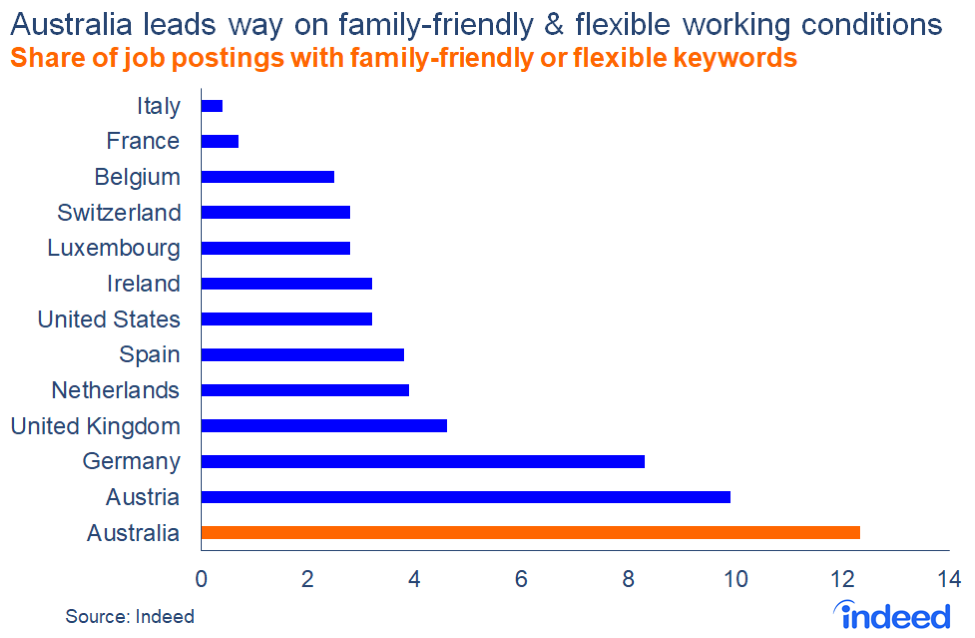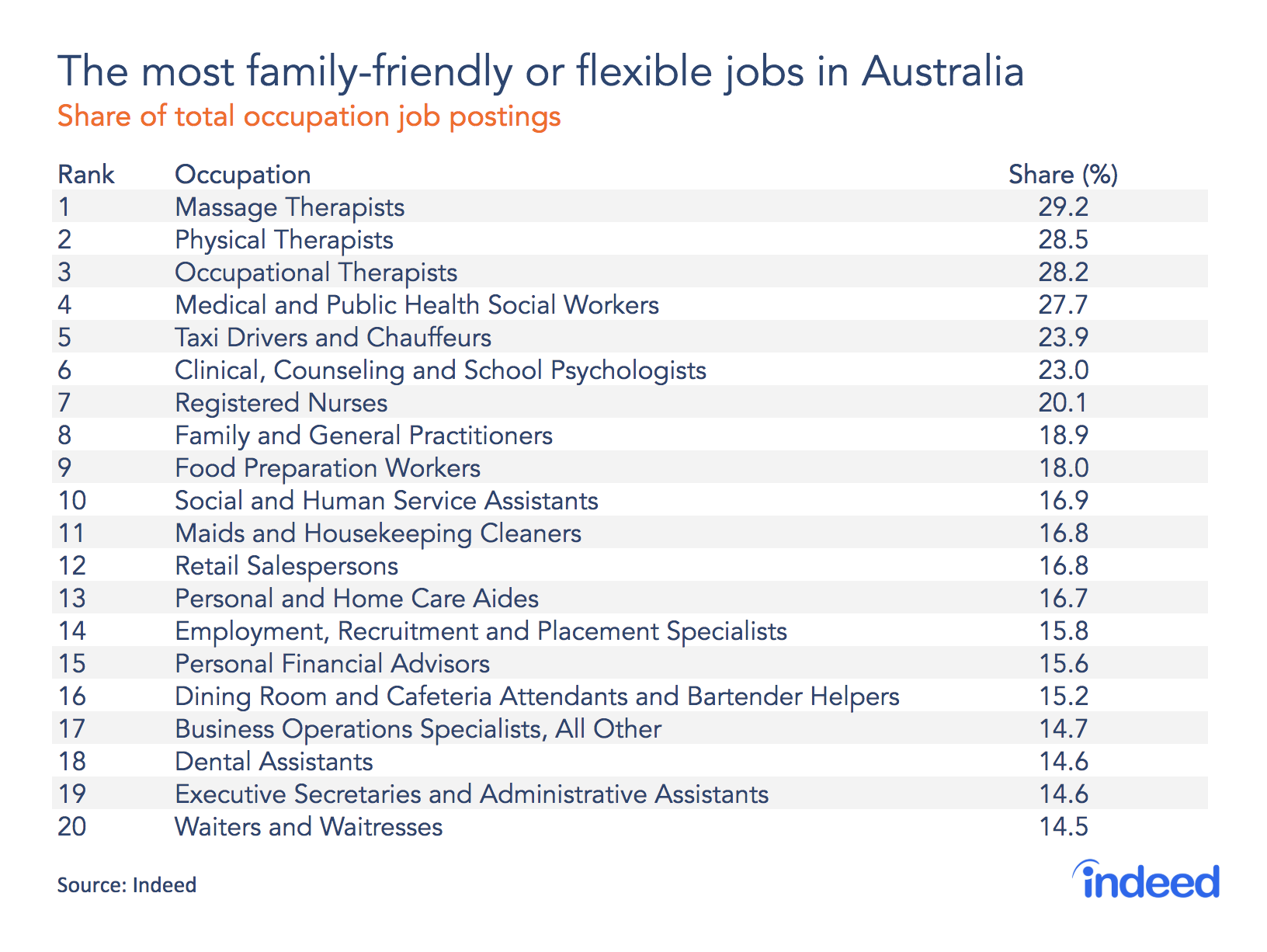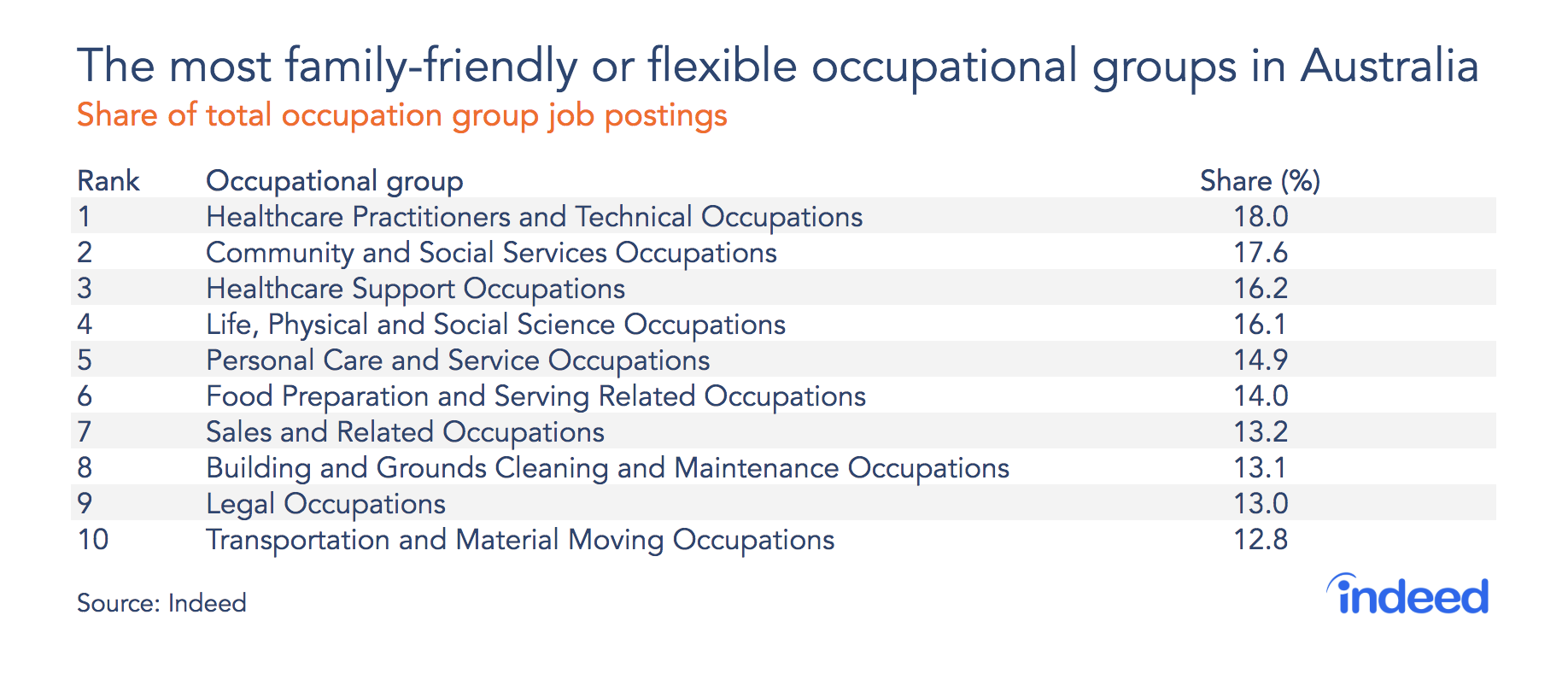Key points:
- The share of Australian job postings using family-friendly or flexible language is well above the United States and many European countries.
- Roles advertised using family-friendly or flexible language account for 12.3% of Australian job postings. But almost a quarter of Australian workers report being overworked.
- Healthcare and social care occupations feature prominently among jobs that place greatest emphasis on work-life balance.
With Father’s Day over the weekend and in honour of Australian parents, it is an opportune time to recognise those occupations that pay more than lip service to work-life balance. At Indeed, we mined hundreds of thousands of job postings to identify those jobs that place greatest emphasis on family-friendly or flexible working environments. For Australian workers, these jobs are not always easy to find: just 12.3% of job postings contain language touting family-friendly or flexible conditions.
All the same, compared to a number of other countries, Australia leads the way when it comes to advertising work-life balance. The share of family-friendly or flexible jobs in Australia ranks ahead of the advanced European economies and the United States. One factor that may explain this is Australia’s high rate of part-time employment. Part-time work accounts for almost a third of total employment in Australia, putting it third behind the Netherlands and Switzerland among OECD countries. What is more, part-time jobs have made up almost half of all employment growth over the past five years, a trend that has helped push labour force participation near a seven-year high.

The changing demographics of Australia’s labour force help explain the rise of part-time work. Over the past decade, women and older workers have dominated employment growth. These two groups have come to define the shift towards more flexible and family-friendly workplaces. With an ageing workforce and the gradual blurring of traditional gender roles, a family-friendly or flexible working environment can be a useful way to attract a wider group of candidates.
Work-life balance a coveted, yet elusive goal for many Australians
Australia stands out globally when it comes to advertising family-friendly jobs. But work-life balance is a long-coveted, but often elusive goal for many Australian workers. Out of 38 countries, Australians ranked ninth among workers in OECD countries when it comes to working long hours and sixth from last for leisure time. Almost a quarter of Australians report they’re overemployed. At the other end of the spectrum, 8.5% of Australian workers say they want to work more hours.
Work-life balance is more complicated than simply total hours worked. It includes policies on such issues as flexible working hours, leave entitlements and ability to work remotely. Some employers more than others recognise the importance of work-life balance and use it as a selling point to attract candidates.
These are Australia’s most family-friendly or flexible jobs
Indeed data can pinpoint which occupations and sectors place greatest emphasis on creating a family-friendly or flexible working environment. Focusing on the top 100 occupations, as determined by total job posts, jobs in the healthcare or social care sectors dominate.
Therapists — of the massage, physical and occupational varieties — are the occupations most likely to offer a family-friendly or flexible working environment. Medical and public health social workers are in fourth place, while taxi drivers round out the top five. Psychologists and registered nurses also rank highly.
As the figure shows, the list of family-friendly or flexible jobs includes a range of high- and lower-skilled occupations. Many of the healthcare sector roles are in the high-skilled category, while jobs such as retail salespeople, food preparation workers, and waiters and waitresses are lower-skilled positions that may offer a great deal of flexibility.
Unfortunately, flexible working hours doesn’t always mean workers can choose their own hours. Sometimes flexible work hours just means you may be working odd hours at your employer’s discretion. Furthermore, casual jobs often lack leave entitlements. So, while these jobs may be flexible, they could be far from family-friendly. The dichotomy between family-friendly and flexible jobs is most likely to be apparent among lower-skilled occupations for which replacing staff is easier.

More broadly, we examined the prevalence of family-friendly or flexible jobs across occupational groups. This is useful since the top twenty occupations in the table are dominated by a small number of occupational groups. While healthcare and social service occupations feature prominently, legal occupations — a sector notorious for long hours — ranks highly. For a legal firm, promoting work-life balance could be a useful way to differentiate itself from competitors, particularly in an occupation in which work-life balance isn’t expected. At the other end of the spectrum, the occupational groups with the lowest share of family-friendly or flexible roles are construction at 4.5% and farming, fishing and forestry at 6.9%.

To be sure, work-life balance is still an elusive goal for many Australian workers. But for some occupations it is a key selling point — helping Australia lead the way when it comes to advertising family-friendly perks.
Methodology
Indeed data on job postings were pulled in early August for Australia, in May for 11 European countries and in late May for the US. To categorize jobs as family-friendly or flexible, descriptions had to include keywords such as work-life-balance, flexible working hours or working remotely. For the European countries, these keywords were searched not only in national languages, but also in English and, if necessary, in additional languages.
What employers promise in their job postings and how the daily work schedule looks might vary greatly. Nevertheless, we assume that mentioning work-life-balance or other keywords related to flexible working arrangements indicates how flexible and family-friendly working conditions actually are.
